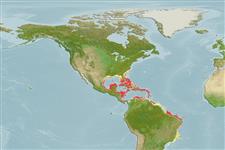Teleostei (teleosts) >
Ovalentaria/misc (Various families in series Ovalentaria) >
Grammatidae (Basslets)
Etymology: Gramma: Greek, gramma, atos = signal, mark (Ref. 45335).
More on author: Poey.
Environment: milieu / climate zone / depth range / distribution range
Ecology
Marine; reef-associated; depth range 1 - 60 m (Ref. 9710), usually 1 - 40 m (Ref. 27115). Tropical; 22°C - 27°C (Ref. 27115)
Western Central Atlantic: Bermuda, Bahamas, and Central America to northern South America.
Length at first maturity / Size / Weight / Age
Maturity: Lm ?, range 3 - ? cm
Max length : 8.0 cm TL male/unsexed; (Ref. 7251)
Often found in caves or under ledges. Swim with belly toward substratum, thus under ledges seen upside down. Feed on ectoparasites of other fishes (Ref. 5521). Males show various types of nest care behavior (Ref. 35580). Retreat into recesses when alarmed (Ref. 9710). Have been reared in captivity (Ref. 35420).
Life cycle and mating behavior
Maturity | Reproduction | Spawning | Eggs | Fecundity | Larvae
Mouthbrooding in this specimen has not been supported by any evidence (Ref. 35580). Prior to spawning, some males established nest sites, using small holes and crevices in the substratum. Females traveled to male nests for egg deposition around dawn. Eggs deposited within the nests were tended by males that established the nests. Males display four types of nest care behaviour: guarding, nest maintenance, detritus clearing,and simple nest entering (Ref. 35580).
Asoh, K. and T. Yoshikawa, 1996. Nesting behavior, male parental care, and embryonic development in the fairy basslet, Gramma loreto. Copeia 1996(1):1-8. (Ref. 35580)
IUCN Red List Status (Ref. 130435)
Threat to humans
Harmless
Human uses
Aquarium: commercial
More information
ReferencesAquacultureAquaculture profileStrainsGeneticsElectrophoresesHeritabilityDiseasesProcessingNutrientsMass conversion
Tools
Special reports
Download XML
Internet sources
Estimates based on models
Preferred temperature (Ref.
123201): 25.1 - 28, mean 27.1 °C (based on 436 cells).
Phylogenetic diversity index (Ref.
82804): PD
50 = 0.5313 [Uniqueness, from 0.5 = low to 2.0 = high].
Bayesian length-weight: a=0.01122 (0.00514 - 0.02450), b=3.04 (2.87 - 3.21), in cm total length, based on all LWR estimates for this body shape (Ref.
93245).
Trophic level (Ref.
69278): 3.3 ±0.41 se; based on food items.
Fishing Vulnerability (Ref.
59153): Low vulnerability (10 of 100).
Nutrients (Ref.
124155): Calcium = 115 [64, 202] mg/100g; Iron = 0.81 [0.50, 1.29] mg/100g; Protein = 18.6 [17.5, 19.6] %; Omega3 = 0.173 [0.105, 0.280] g/100g; Selenium = 25.4 [12.9, 46.5] μg/100g; VitaminA = 184 [63, 540] μg/100g; Zinc = 2.18 [1.51, 3.03] mg/100g (wet weight);
